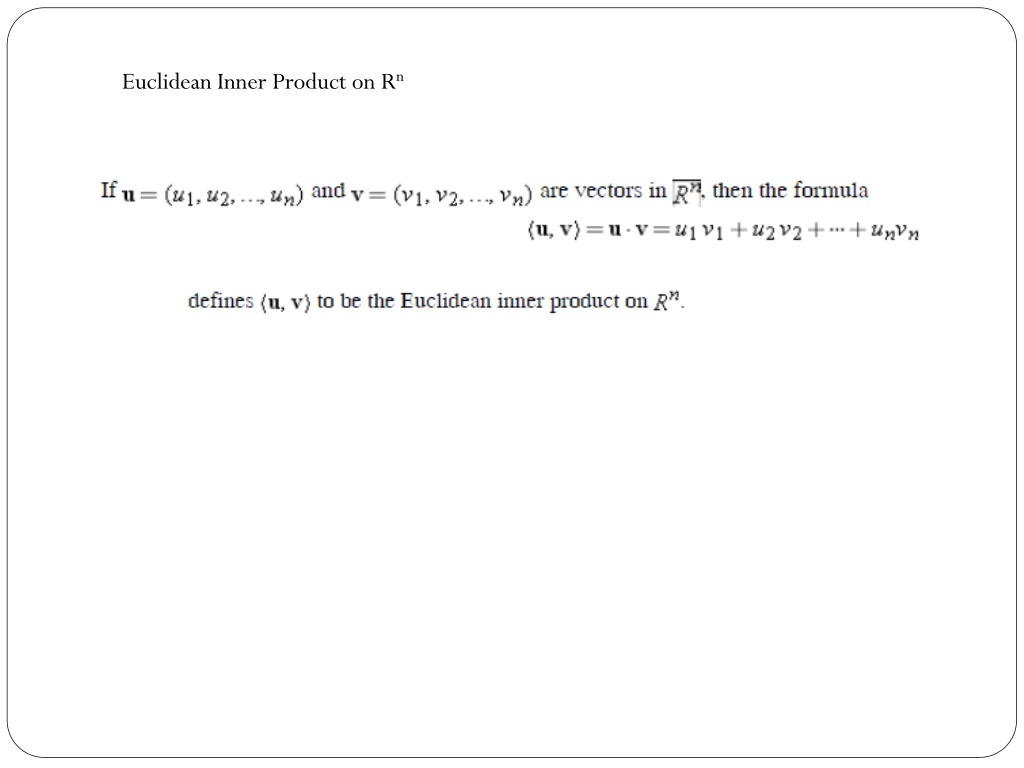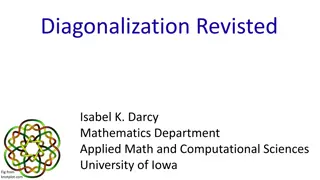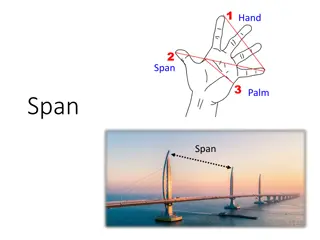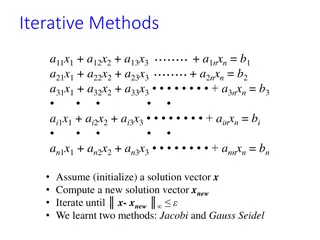Understanding Eigenvalues and Eigenvectors in Linear Algebra
Explore the concepts of eigenvectors and eigenvalues in linear algebra, from defining orthonormal bases and the Gram-Schmidt process to finding eigenvalues of upper triangular matrices. Learn the theorems and examples that showcase the importance of these concepts in matrix operations and transformations.
Download Presentation

Please find below an Image/Link to download the presentation.
The content on the website is provided AS IS for your information and personal use only. It may not be sold, licensed, or shared on other websites without obtaining consent from the author. Download presentation by click this link. If you encounter any issues during the download, it is possible that the publisher has removed the file from their server.
E N D
Presentation Transcript
ORTHONORMAL BASES; GRAMSCHMIDT PROCESS DEFINITION A set of vectors in an inner product space is called an orthogonal set if all pairs of distinct vectors in the set are orthogonal. An orthogonal set in which each vector has norm 1 is called orthonormal. EXAMPLE Using the Gram Schmidt Process
Chapter 7 Eigenvalues, Eigenvectors
7.1EIGENVALUES AND EIGENVECTORS DEFINITION
This is called the characteristic equation of A The determinant is always a polynomial p in p( ), called the characteristic polynomial of A.
EXAMPLE 3 Eigenvalues of an Upper Triangular Matrix Find the eigenvalues of the upper triangular matrix
THEOREM 7.1.1 If A is an nxn triangular matrix (upper triangular, lower triangular, or diagonal), then the eigenvalues of A are the entries on the main diagonal of A. EXAMPLE 4 Eigenvalues of a Lower Triangular Matrix By inspection, the eigenvalues of the lower triangular matrix
EXAMPLE 5 Eigenvectors and Bases for Eigenspaces Find bases for the eigenspaces of are linearly independent, these vectors form a basis for the eigenspace corresponding to =2. If =1, then
Powers of a Matrix THEOREM 7.1.3 EXAMPLE 6 : Find eigenvalues of A7
Eigenvalues and Invertibility THEOREM 7.1.4 A square matrix A is invertible if and only if =0 is not an eigenvalue of A. EXAMPLE 7 Using Theorem 7.1.4 The matrix A in Example 5 is invertible since it has eigenvalues
THEOREM 7.1.5 Equivalent Statements If A is an nxn matrix, and if TA: Rn (a) A is invertible. (b) AX=0 has only the trivial solution. (c) The reduced row-echelon form of A is In. (d) A is expressible as a product of elementary matrices. (e) AX=b is consistent for every nx1 matrix b . (f) AX=b has exactly one solution for every nx1 matrix b. Rnis multiplication by A, then the following are equivalent.
(g) det(A) 0. (j) The column vectors of A are linearly independent. (k) The row vectors of A are linearly independent. (l) The column vectors of A span Rn. (m) The row vectors of A span Rn. (n) The column vectors of A form a basis for Rn. (o) The row vectors of A form a basis for Rn. (p) A has rank n. (q) A has nullity 0. (r) The orthogonal complement of the nullspace of A is Rn. (s) The orthogonal complement of the row space of A is {0}. (t) ATA is invertible. (u) =0 is not an eigenvalue of A.
7.2DIAGONALIZATION The Matrix Diagonalization Problem DEFINITION A square matrix A is called diagonalizable if there is an invertible matrix P such that P-1AP is a diagonal matrix; the matrix P is said to diagonalize A. THEOREM 7.2.1 If A is an nxn matrix, then the following are equivalent. (a) A is diagonalizable. (b) A has n linearly independent eigenvectors.
EXAMPLE 1 Finding a Matrix P That Diagonalizes a Matrix A Find a matrix P that diagonalizes
EXAMPLE 2 A Matrix That Is Not Diagonalizable Find a matrix P that diagonalizes
THEOREM 7.2.2 THEOREM 7.2.3 If an nxn matrix A has n distinct eigenvalues, then A is diagonalizable. EXAMPLE 3 Using Theorem 7.2.3
THEOREM 7.2.4 Geometric and Algebraic Multiplicity If A is a square matrix, then (a) For every eigenvalue of A, the geometric multiplicity is less than or equal to the algebraic multiplicity. (b) A is diagonalizable if and only if, for every eigenvalue, the geometric multiplicity is equal to the algebraic multiplicity. Computing Powers of a Matrix























